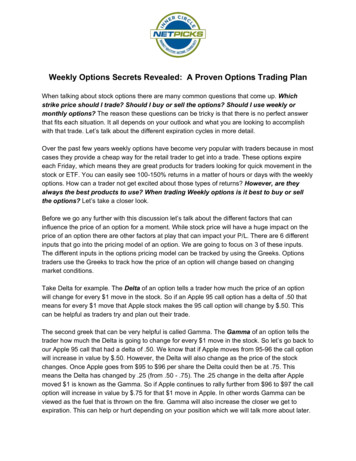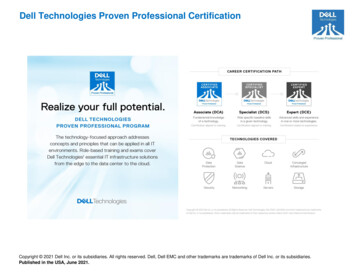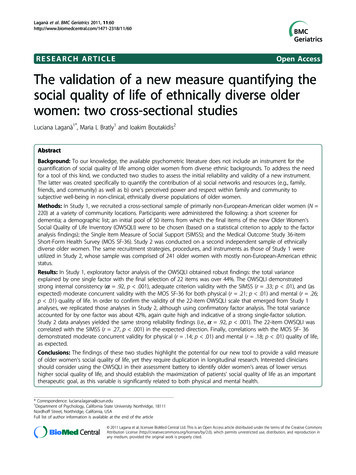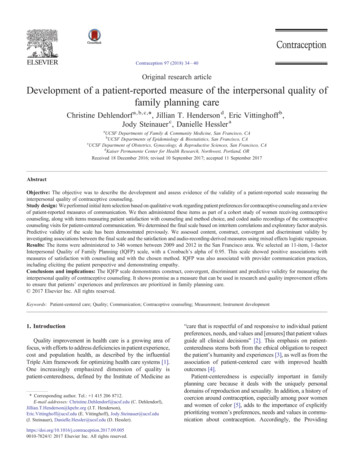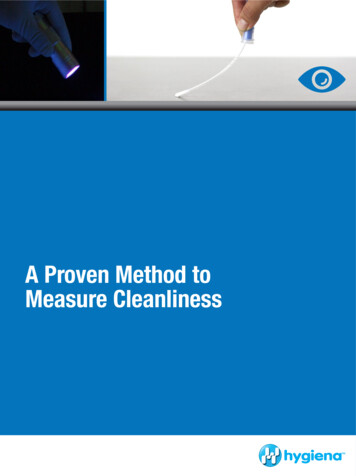
Transcription
A Proven Method toMeasure Cleanliness
TABLE OF CONTENTSATP Testing: A Proven Methodto Measure Cleanliness. 3Methods to Gauge Cleanliness. 3Scrapping a ‘Pretty Basic’ Monitoring Program . 5A ‘Trust but Verify’ Approach . 7The Science Behind the Programs . 8In the Long-Term . 9Side by Side Method Comparison . 10References . 102Copyright 2015 Hygiena.
ATP Testing:A Proven Method to MeasureCleanlinessIt is estimated that20% to40%of all healthcareassociatedinfections are fromunclean surfacesand the hands ofhealthcare workers(Weber, 2010).By Karin Lillishe most stringent hand hygiene program or expensive terminal disinfecting deviceis no match for poor cleaning practices. Elbow grease and the right products andtools are essential to ensure healthcare facilities remain as pathogen-free as possible.It is estimated that 20 percent to 40 percent of all healthcare-associated infections arefrom unclean surfaces and the hands of healthcare workers (Weber, 2010). Research alsoindicates that only 34 percent to 40 percent of hospital surfaces are cleaned to policystandards (Carling, 2010).But how can that happen?A recent literature review helps to explain why (Amodio and Dino, 2014). “Hospitalcleanliness tends to be thought of by patients and the public as an important indicator ofthe general quality of healthcare, primarily due to the fact that dirty surfaces can be highlycontaminated by microorganisms that expose patients to the risk of acquiring infections,”the researchers write.“This risk can be alarming in hospital settings, and several studies have well documentedthe environmentally mediated transmission of antibiotic-resistant pathogens. Despite thisfinding, routine housekeeping practices are often suboptimal, and some authors haveobserved that disinfection can be improved to 82 percent, resulting in an average 68 percentdecrease in bacteriological environmental contamination. As a consequence, cleaningand disinfecting hospital environments have been claimed as one of the best strategies forpreventing healthcare-associated colonization and infections.”TMethods to Gauge CleanlinessHealthcare organizations typically rely on one or more of the following methods tomeasure cleanliness (Guh and Carling, 2010). In 2010, the Centers for Disease Control andPrevention (CDC) produced a toolkit—Options for Evaluating Environmental Cleaning—whichencourages hospitals to monitor the performance of cleaning by using an objective method(Guh and Carling, 2010). Those methods include:Visual inspection: An environmental services (EVS) supervisor or other staff memberchecks a room, device or equipment to determine whether it “looks” clean. While this method3Copyright 2015 Hygiena.
Despite thisfinding, routinehousekeepingpractices are oftensuboptimal, andsome authorshave observed thatdisinfection canbe improved to82% resultingin an average68% decreasein bacteriologicalenvironmentalcontamination4is inexpensive and fast, infection control professionals view this method as unacceptablebecause of its lack of objectivity (Mulvey, 2011). Direct observation, however, is a usefulteaching tool and can immediately assess an EVS worker’s cleaning routine. “Covert monitoringof disinfection cleaning can provide an objective assessment of individual (environmentalservices) staff performance and compliance with cleaning protocols,” the CDC toolkit states(Guh and Carling, 2010). “(The) complexity of monitoring cleaning practice in individualpatient rooms without the evaluator being recognized as such might represent a difficultconfounding issue.”Fluorescent markers/gels: A surface is marked with one of these types of glow-in-thedark products, before EVS staff enter to clean the room. Once that cleaning is performed,another supervisor or staff member shines a black light on the previously marked surface. Ifthe fluorescent substance is still present, it is an indication that the surface might not havebeen properly cleaned. “Fluorescent gel dries transparent on surfaces, resists abrasions andthere are several studies demonstrating the accuracy of the system in objectively evaluatingcleaning practice and quantifying the impact of educational interventions on such cleaning,”the CDC guidelines state (Guh and Carling, 2010). “Because these fluorescent markersare all designed to indicate physical removal of an applied substance, surfaces that areeffectively disinfected but less effectively cleaned are more likely flagged as failing to meeta quality standard using one of these markers than (a) culture technique.” This type oftesting is relatively low-tech and simple to perform, however it can be very time consuming.The method requires two trips to the room (before and after cleaning)—and it might notdetermine whether the surface is actually clean. For instance, an EVS worker may wipedown the surface with a dirty rag.Microbiology testing: After a surface has been cleaned, samples are taken, usuallyvia swab, and sent to the hospital lab to gauge which pathogens—if any—may still bepresent. This method has proven effective at targeting specific pathogens that may betroublesome to a healthcare facility, but cultures take two to four days to grow and typicallyrequire interpretation by a microbiologist. “Although swab cultures are easy to use, the costof processing, including isolate identification, the delay in results, the need to determinepre-cleaning levels of contamination for each object evaluated in order to accurately assesscleaning practice, and the limited feasibility of monitoring multiple surfaces in multiplepatient rooms as part of an ongoing monitoring program represent issues which couldlimit the broad application of this system,” the CDC toolkit states (Guh and Carling, 2010).A second method, Agar culture testing, is used to evaluate a cleaning practice by“quantifying aerobic colony counts (ACCs).” Agar coated slides, originally designedto “simplify quantitative cultures of liquids,” is also used in the healthcare setting forenvironmental surfaces monitoring (Guh and Carling, 2010). “Although some difficultieshave been encountered in utilizing agar slide cultures on other than large, flat surfaces, theypotentially provide an easy method for quantifying viable microbial surface contamination,”Copyright 2015 Hygiena.
The softwareallowsmanagersto generatepre-set reportsthat can beeasily sharedamong EVSand otherfrontline staff,and with theinfectioncontroldepartmentand hospitalleadership.the CDC states (Guh and Carling, 2010). “There is a need, similar to that noted for aboveswab cultures, to determine pre-cleaning levels of contamination for each object evaluatedin order to accurately assess cleaning practices.”ATP monitoring: This measures residual organic matter that may remain after a surface,device or piece of equipment is cleaned. Adenosine triphosphate (ATP) is an enzyme that ispresent in all organic matter—living and once-living—including blood, saliva and bacteria.Essentially, the person conducting ATP monitoring swabs the surface to be tested and insertsthat swab into a handheld unit called a luminometer. Results are available within seconds.All ATP systems also come with software that allows the user to track trends and monitordata, such as EVS personnel performance and overall cleaning thoroughness. This method,however, doesn’t detect the type of bioburden or pathogens left on the surface. ATP testingis sometimes misunderstood as a microorganism detection method—but only microbiologytesting can fill that role. But since any organic residue is a food source for bacteria, knowinga surface’s general cleanliness is just as valuable for cleaning.“Although it is likely that part of the lack of correlation between ATP readings and ACCs relates to the fact that ATP systems measure organic debris as well as viable bacterialcounts, several studies have noted additional environmental factors which may increase ordecrease ATP readings,” the CDC toolkit notes (Guh and Carling, 2010). “Because a largeproportion of surface containing ATP is non-microbial in origin, surfaces that are effectivelydisinfected but less effectively cleaned may be more likely flagged as failing to meet aquality standard.”The last method—ATP monitoring—has shown promise as an objective and reliable meansto measure cleanliness. Products like Hygiena’s SystemSURE Plus ATP cleaning verificationsystem allow users to simply swab any surface and drop the swab into a handheld detectionunit (luminometer) that immediately measures the results, and report and analyze the datathrough a specialized software system.Hygiena’s SureTrend software application helps EVS managers track ATP test results,quickly home in on problem areas, and compare results among different units or multiplefacilities. The software allows managers to generate pre-set reports that can be easilyshared among EVS and other frontline staff, and with the infection control department andhospital leadership. SureTrend also allows healthcare facilities to maintain records to ensurecompliance with in-house and regulatory practices and policies.Scrapping a ‘Pretty Basic’ Monitoring ProgramBefore introducing ATP testing, HealthSouth Deaconess Rehabilitation Hospital in Evansville,Ind. relied on a “pretty basic” program—a “cleaning detective” would spray a fluorescentsolution on a surface prior to cleaning, allow the EVS staff to perform the cleaning, andthen check the surface with a black light, says Eddie Gomez, senior manager of informationsystems, environmental services and laundry.“There was no software to tabulate the scores. We just scored ‘pass’ or ‘fail,’ and then5Copyright 2015 Hygiena.
ATP testing,has helpedEVS staffmaintaincontrol ofthe cleaningprocess andunderstand“how we werefailing with ourold process.”6obtained a percentage for that nursing unit and for the whole hospital,” he notes. “I wasnot very convinced this would work. My fears were confirmed. The spray left spots on someareas that remained after weeks of being cleaned. The spots still showed up under theblacklight, which made me question that method's effectiveness. I suspended the programuntil I found something better."During his experience in the restaurant and dietary field, Gomez says he had heard aboutATP testing and “thought it was something we could trial—since it had started taking off inthe EVS field.” He also was searching for a software tabulation program that would allowhim to organize and break down results by more than just one nursing unit.“We wanted to determine a certain number of results per day, based on individual EVSworkers,” Gomez says.ATP testing, he says, has helped EVS staff maintain control of the cleaning process andunderstand “how we were failing with our old process.” ATP verification allowed Gomez andEVS leaders to better educate staff and to create a sense of urgency around proper cleaning.HealthSouth first introduced ATP testing as a pilot project in October 2014. During thetrial phase, project leaders created a benchmark and dedicated their time to “understandingthe system and how it worked,” says Gomez. The hospital first launched ATP testing onone nursing unit before integrating the technology hospital-wide.“EVS staff took it seriously and personally. When the luminometer showed higher readings,staff were astonished by the results,” Gomez says. “Visually, things looked cleaned—butthe luminometer said otherwise. This was an eye-opening experience for all of us—hospitalstaff and management teams included.”With the help of HealthSouth’s infection control coordinator, Gomez introduced ATPtesting in the facility. “It’s something we could not live without now,” he says. HealthSouthDeaconess is currently considering expanding ATP testing to dietary services, inpatient therapygyms and medical practice offices.Before launching the hospital’s ATP testing program, Gomez says he researched themethod and obtained feedback from local hospitals that already use the technology. “Ispoke with Hygiena’s representative as well. We had several calls and discussed the manypros and cons before I decided to propose ATP testing to our CEO and CFO,” Gomez says.“The feedback and support was amazing.”Gomez presented the proposal to the hospital’s quality and safety councils for approval.“Once we obtained that approval, we informed our EVS staff how this program was going towork. Support from the EVS department was about 50-50. Staff knew ATP testing wouldn’tmake the cleaning process easier at first, but eventually they all understood that we had totry it before we could say, ‘No, this isn’t going to work,’” Gomez notes.During the first few months of implementation, Gomez says, the EVS departmentstruggled to meet the hospital benchmark—but the “will to persevere from everyone wasunbelievable.” Recently, the hospital has reported “some of the best results we’ve had inmany years,” he says.Copyright 2015 Hygiena.
Before, youmight walk intoa room, verifythat it lookedand smelledclean—andhope that itactually wasclean. Now,you knowwhether thatroom is cleanor not. It givesyou peace ofmind—anda qualitativeapproach tosharing datawith your staff.7“ATP testing has truly helped us become aware of our cleaning techniques,” Gomezsays. “We now hold educational meetings to discuss the program’s success and areas wherewe still have trouble—to make sure we’re quick to correct any problems that consistentlyshow up in our ‘fails’ report.”ATP testing, Gomez says, provides beneficial education and awareness for EVS staff, butit also “gives the sense of cleanliness” to hospital staff and patients.“I am very happy I made the changes, and so are many of my staff,” Gomez says. “Theylove how we can tell them—on the spot—whether something was properly cleaned. It hasalso created a little bit of friendly competition within the department. No one wants to getlow scores.”A ‘Trust but Verify’ ApproachThe Western Connecticut Health Network has used Hygiena’s ATP system for three years,says Michael Murphy, CHESP, REH, director of support services and system specialist at theNorwalk, Conn.-based healthcare system. An EVS supervisor or manager swabs high-touchareas in 10 rooms on each shift—day and night, occupied or unoccupied. The hospital alsoconducts random testing that includes equipment like stretchers and wheelchairs.Before the hospital launched its ATP testing system, EVS staff relied on visual inspectionand fluorescent markers to gauge a room’s cleanliness. Neither technique was especiallyobjective or fool-proof, Murphy says. The second method was especially cumbersome.“A supervisor had to run in the room and mark high-touch areas with the glow stick. Ifa housekeeper saw the supervisor coming out of the room, he or she knew something wasup,” Murphy says. “I knew there must be a better way to monitor cleanliness.”ATP testing, he says, is a “trust but verify” approach to monitoring cleanliness. “Before,you might walk into a room, verify that it looked and smelled clean—and hope that itactually was clean. Now, you know whether that room is clean or not. It gives you peaceof mind—and a qualitative approach to sharing data with your staff.”He explains how the process works: “We’ll approach a housekeeper and ask if he or sheis done cleaning. We’ll walk in the room behind that staff member and start swabbing.We check both discharge and occupied rooms—one to 10 swabs in each room. The EVSemployee sees the score and signs off on it.”Recently, a review by an independent company netted the healthcare system the highestscore for cleanliness among the more than 600 facilities the company surveyed. Murphysays ATP testing played a significant role in that achievement.The EVS department also reports results of ATP inspections to the infection controlspecialist and committee. “Our infection control specialist has actually watched us do ourinspections to see how staff performs that duty,” Murphy says. “Our infection rates arevery low—and that’s a credit to everyone.”ATP testing, he notes, “keeps everyone honest and on their toes. We have good employeeswho want to do good work—and want to know they’re doing good work. We have a greatstaff who don’t want to miss anything.”Copyright 2015 Hygiena.
ATP readings canprovide realtime feedbackto housekeepersregarding theirperformance, anadvantage overthe 24 to48 hoursrequired to obtainresults usingmicrobiologicalmethods.8The Science behind the ProgramsIn a two-phase study at a university-affiliated teaching hospital, researchers showed thateducating housekeeping staff leads to lower ATP readings (Boyce, 2009).The first phase targeted five high-touch areas in 20 patient rooms—bedside rails, overbedtables, television remote controls, toilet seats and grab bars in patient bathrooms. Sampleswere taken shortly before EVS staff entered the room and about 10 minutes after they left,to allow the surface disinfectants time to dry. “The major goal of phase two of our studywas to establish with greater certainty the range of ATP readings to be expected on hightouch surfaces in patient rooms before and after daily cleaning,” the researchers write.During the second half of the study, the researchers wanted to determine if and howeducating housekeeping staff “would result in improved cleaning practices.” At thebeginning of phase two, a member of the infection control team reviewed the results ofphase 1 with EVS staff. The sessions focused on the “role of daily cleaning to prevent thespread of pathogens on contaminated surfaces.”During the second phase, two EVS managers were trained to use the swabs and ATPluminometers. They also notified housekeeping staff that they were monitoring certainsurfaces in patient rooms. This time, more than 1,000 before-and-after samples were takenfrom the same five high touch areas, from 105 patient rooms on 16 wards.“High-touch surfaces were significantly cleaner” during phase two, the researchers write.“This assay could also be used to evaluate the final cleaning procedures. ATP readings canprovide real-time feedback to housekeepers regarding their performance, an advantage overthe 24 to 48 hours required to obtain results using microbiological methods.Another study in Glasgow, Scotland (Mulvey, 2011) evaluated methods for monitoringhospital cleanliness benchmarks, including visual inspection and ATP monitoring. Over afour-week period on two hospital wards, the researchers collected samples from a handfulof clinical areas before and after “detergent-based cleaning,” the researchers write.“Microbiological and ATP monitoring confirmed environmental contamination, persistenceof hospital pathogens and measured the effect on the environment from current cleaningpractices.”Specifically, samples were taken on one medical and one surgical ward at a teachinghospital in Glasgow. ATP monitoring was conducted two to three times a week on areasincluding the bedside locker, bed frame, overbed table, bedside curtain, computer keyboardsand restroom door push plate.“Since visual assessment does not offer reliable information on infection risk to patients,high-risk (hand touch) surfaces in hospitals should be subjected to a scientific screeningmethod in order to monitor overall levels of microbial dirt. If integrated into a formalmonitoring regimen, ATP would help identify unacceptable soil levels and associatedpatient risk, provided they are systematically collected over time and interpreted correctly,”the researchers write.Copyright 2015 Hygiena.
Before, youmight walk intoa room, verifythat it lookedand smelledclean—andhope that itactually wasclean. Now,you knowwhether thatroom is cleanor not. It givesyou peace ofmind—anda qualitativeap
Essentially, the person conducting ATP monitoring swabs the surface to be tested and inserts that swab into a handheld unit called a luminometer. Results are available within seconds. All ATP systems also come with software that allows the user to track trends and monitor data, such as EVS personnel performance and overall cleaning thoroughness.

